Advertisements
Chapters
2: Cell : The Unit of Life
3: Tissues : Plant and Animal Tissues
4: The Flower
▶ 5: Pollination and Fertilization
6: Seeds - Structure and Germination
7: Respiration in Plants
8: Five Kingdom Classification
9: Economic Importance of Bacteria and Fungi
10: Nutrition
11: Digestive System
12: Skeleton - Movement and Locomotion
13: Skin - "The Jack of all Trades"
14: The Respiratory System
15: Hygiene - [A Key to Healthy Life]
16: Diseases : Cause and Control
17: Aids to Health
18: Health Organisation
19: Waste Generation and Management
![Selina solutions for Concise Biology [English] Class 9 ICSE chapter 5 - Pollination and Fertilization Selina solutions for Concise Biology [English] Class 9 ICSE chapter 5 - Pollination and Fertilization - Shaalaa.com](/images/4567167791-concise-biology-english-class-9-icse_6:778c9d06bf3248a296d8ab25ff5c174b.jpg)
Advertisements
Solutions for Chapter 5: Pollination and Fertilization
Below listed, you can find solutions for Chapter 5 of CISCE Selina for Concise Biology [English] Class 9 ICSE.
Selina solutions for Concise Biology [English] Class 9 ICSE 5 Pollination and Fertilization Multiple choice type [Page 45]
Which one of the following is one of the characteristics of self-pollinated flowers?
Flowers are large and showy
Flowers remain closed and do not open
Stigma and anthers mature at the same time
Pollen is produced in very large quantities
Exine and intine are the parts of
Embryo sac
Pollen grain
Stigma
Seed
Selina solutions for Concise Biology [English] Class 9 ICSE 5 Pollination and Fertilization Very short answer type [Page 46]
State the name of the chief pollinating agent against the corresponding plant by choosing from those given in brackets.
Dahlia_______ .
crow
butterflies
mosquito
State the name of the chief pollinating agent against the corresponding plant by choosing from those given in brackets.
Maize_______ .
bees
locusts
rain
wind
State the name of the chief pollinating agent against the corresponding plant by choosing from those given in brackets.
Vallisneria ______
wind
water
ants
rabbits
Match the items in Column A with those in Column B.
|
Column A |
Column B |
|
(a) Generative nucleus |
(i) Pollen tube |
|
(b) Germ pore |
(ii) Endosperm nucleus |
|
(c) Exine |
(iii) Testa |
|
(d) Secondary nucleus |
(iv) Fertilization |
|
(e) Integument |
(v) Male nuclei |
|
(f) Egg nucleus |
(vi) Rough |
Fill in the blanks with suitable words.
Transference of pollen grains from anthers to stigma of the same flower is called ________.
Fill in the blanks with suitable words.
Different timings for the maturation of gynoecium and androecium is called ________.
Fill in the blanks with suitable words.
_______ is a water-pollinated flower.
Name of the part of the ovary which gives rise to:
Seed ______
Name of the part of the ovary which gives rise to:
Fruit ______
Name of the parts of the ovary which give rise to:
Fruit wall ______
Give one word/term for the following:
A flower containing both male and female parts.
Give one word/term for the following:
Arrangement of flowers on a twig/stem.
Give one word/term for the following:
When pollen grains of a flower reach the stigma of the same flower.
When maturation time of reproductive parts in a flower is different.
Give one word/term for the following:
When stigma and anthers do not grow up to the same height, which favors only cross-pollination.
Give one word/term for the following:
Pollination of flowers by insects.
Give one word/term for the following:
Pollination of flowers by birds.
Selina solutions for Concise Biology [English] Class 9 ICSE 5 Pollination and Fertilization Short answer type [Page 46]
Explain the Following Term:
Ornithophily
Explain the following term:
Elephophily
Explain the following term:
Artificial pollination
What happens to the following after fertilization?
Ovules
What happens to the following after fertilization?
Calyx
What happens to the following after fertilization?
Petals
What happens to the following after fertilization?
Stamens
Mention any two contrivances in flowers which favour cross-pollination.
Selina solutions for Concise Biology [English] Class 9 ICSE 5 Pollination and Fertilization Long answer type [Page 46]
What are the advantages of the following in the flower to the plant concerned?
Long and feathery stigma
What are the advantages of the following in the flower to the plant concerned?
Brightly coloured petals
What are the advantages of the following in the flower to the plant concerned?
Smooth and light pollen
What are the advantages of the following in the flower to the plant concerned?
Protruding and easily movable anthers
What are the advantages of the following in the flower to the plant concerned?
Fragrant nectar
Describe the advantages and disadvantages of cross-pollination to the plant.
Selina solutions for Concise Biology [English] Class 9 ICSE 5 Pollination and Fertilization Structured/Application/Skill Type [Page 46]
What is the function of the pollen tube? Explain it with the help of a diagram.
Given ahead is a diagrammatic sketch of the sectional view of a germinating pollen grain. Study the same and then answer the question that follows:
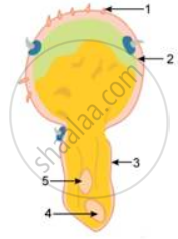
Name the parts labelled 1, 2, 3, 4 and 5.
Given ahead is a diagrammatic sketch of the sectional view of a germinating pollen grain. Study the same and then answer the question that follows:
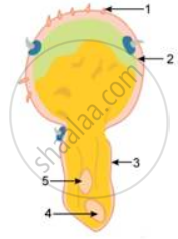
Where does the germination of the pollen grain take place and how?
Given ahead is a diagrammatic sketch of the sectional view of a germinating pollen grain. Study the same and then answer the question that follows:
What is the function of the part labelled '4'?
Given ahead is a diagrammatic sketch of the sectional view of a germinating pollen grain. Study the same and then answer the question that follows:
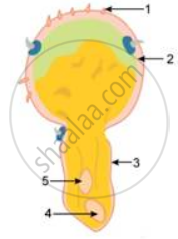
What happens to the part labelled '5' during the process?
Given ahead is a diagrammatic representation of the process of fertilization. Study the same and then answer the question that follows:
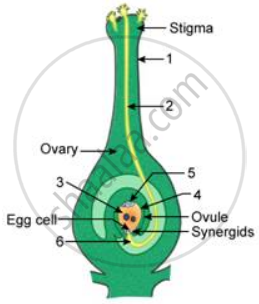
Name the parts labelled 1, 2, 3, 4, 5 and 6.
Given ahead is a diagrammatic representation of the process of fertilization. Study the same and then answer the question that follows:
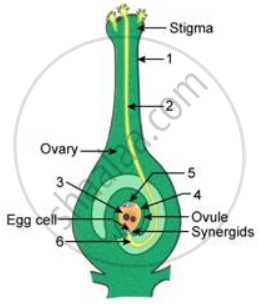
What happens to
i) Ovary
ii) Ovule after fertilisation
Given ahead is a diagrammatic representation of the process of fertilization. Study the same and then answer the question that follows:
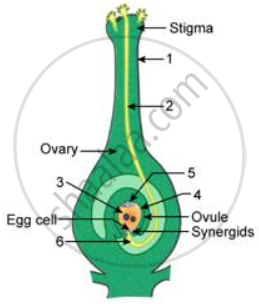
What is the function of the synergids?
Given ahead is a diagrammatic representation of the process of fertilization. Study the same and then answer the question that follows:

What part does the stigma play in the process of fertilisation?
Solutions for 5: Pollination and Fertilization
![Selina solutions for Concise Biology [English] Class 9 ICSE chapter 5 - Pollination and Fertilization Selina solutions for Concise Biology [English] Class 9 ICSE chapter 5 - Pollination and Fertilization - Shaalaa.com](/images/4567167791-concise-biology-english-class-9-icse_6:778c9d06bf3248a296d8ab25ff5c174b.jpg)
Selina solutions for Concise Biology [English] Class 9 ICSE chapter 5 - Pollination and Fertilization
Shaalaa.com has the CISCE Mathematics Concise Biology [English] Class 9 ICSE CISCE solutions in a manner that help students grasp basic concepts better and faster. The detailed, step-by-step solutions will help you understand the concepts better and clarify any confusion. Selina solutions for Mathematics Concise Biology [English] Class 9 ICSE CISCE 5 (Pollination and Fertilization) include all questions with answers and detailed explanations. This will clear students' doubts about questions and improve their application skills while preparing for board exams.
Further, we at Shaalaa.com provide such solutions so students can prepare for written exams. Selina textbook solutions can be a core help for self-study and provide excellent self-help guidance for students.
Concepts covered in Concise Biology [English] Class 9 ICSE chapter 5 Pollination and Fertilization are Fertilization Process, Pollination, Self Pollination (Autogamy), Cross Pollination, Agents of Pollination, Artificial Pollination, Fertilization in Plants.
Using Selina Concise Biology [English] Class 9 ICSE solutions Pollination and Fertilization exercise by students is an easy way to prepare for the exams, as they involve solutions arranged chapter-wise and also page-wise. The questions involved in Selina Solutions are essential questions that can be asked in the final exam. Maximum CISCE Concise Biology [English] Class 9 ICSE students prefer Selina Textbook Solutions to score more in exams.
Get the free view of Chapter 5, Pollination and Fertilization Concise Biology [English] Class 9 ICSE additional questions for Mathematics Concise Biology [English] Class 9 ICSE CISCE, and you can use Shaalaa.com to keep it handy for your exam preparation.
